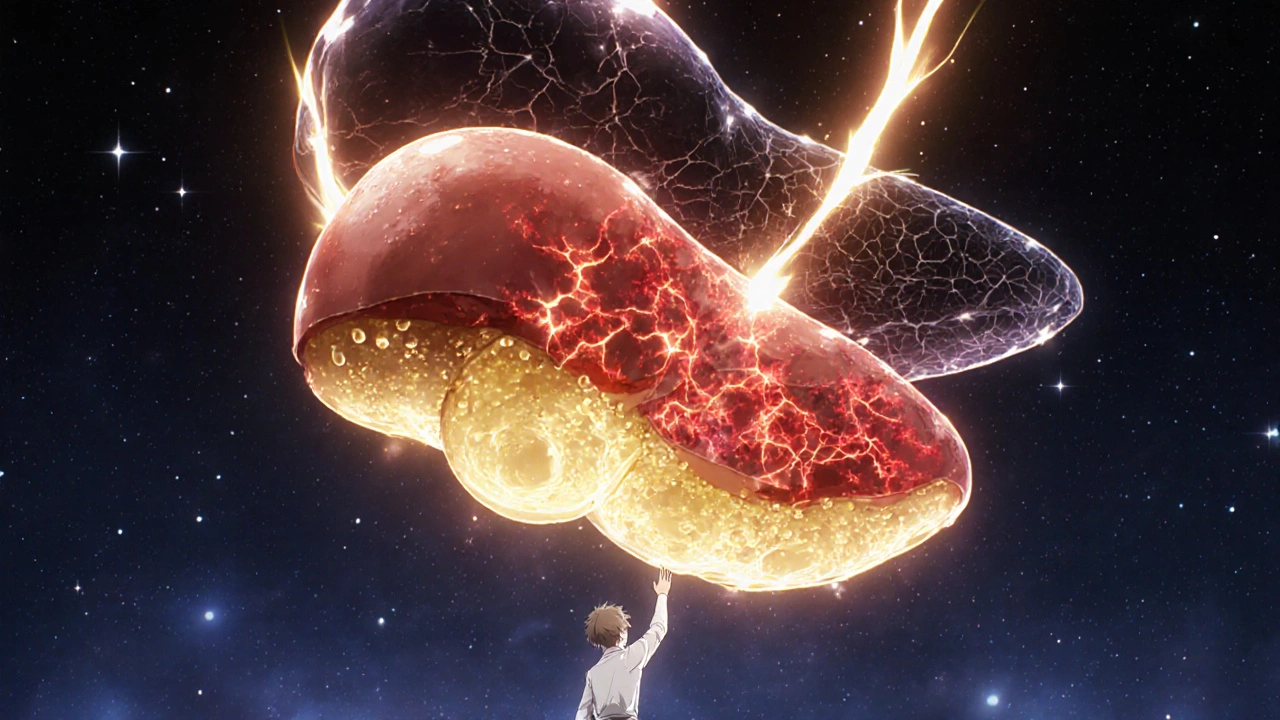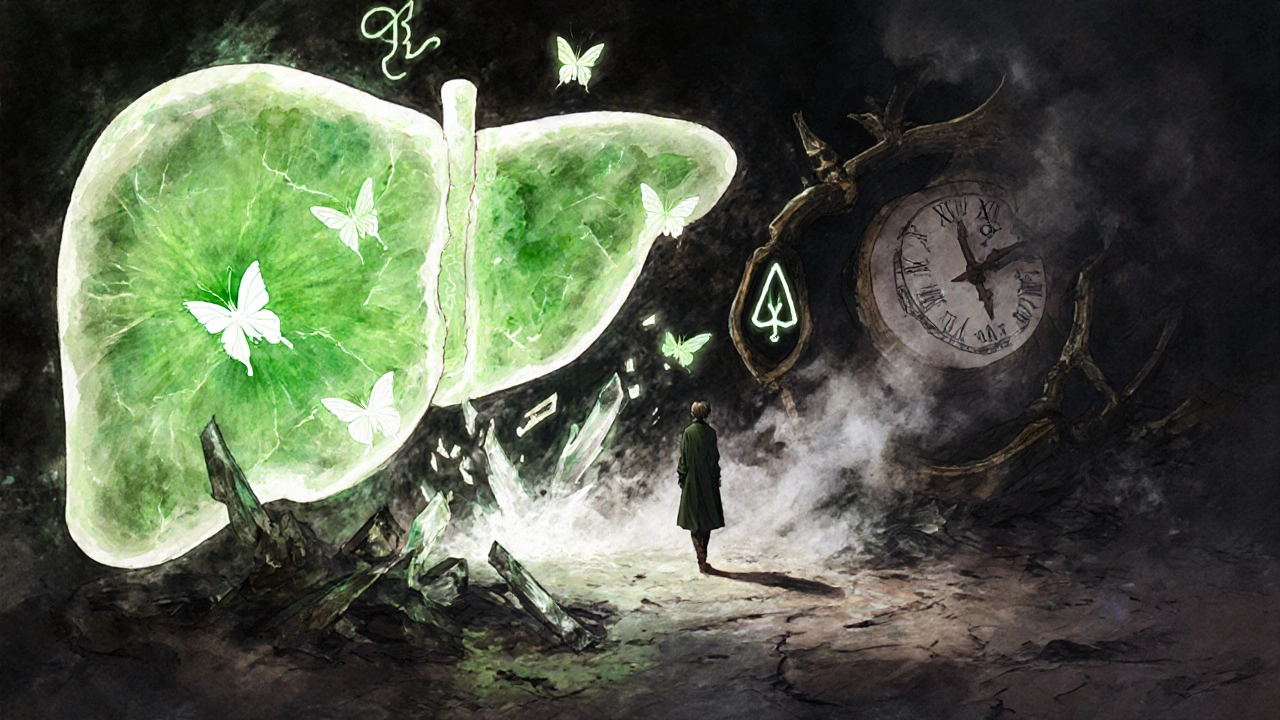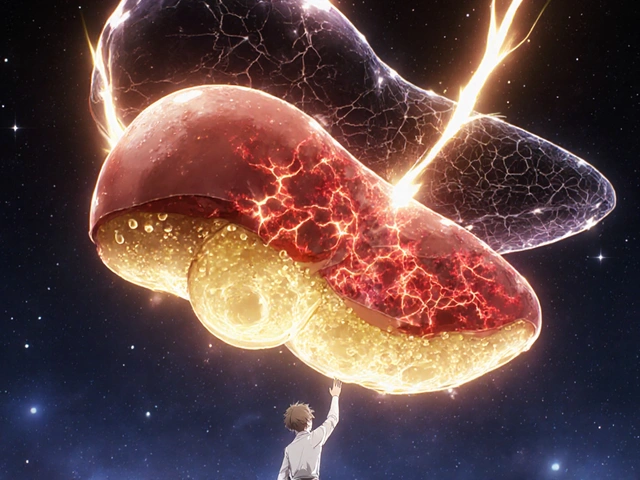Alcoholic Liver Disease: Understanding the Stages from Fatty Liver to Cirrhosis

Most people don’t realize their liver is silently breaking down until it’s too late. Alcohol-related liver damage doesn’t come with a warning siren. It creeps in quietly, often without symptoms, until one day you’re jaundiced, swollen, or struggling to stay awake. By then, the damage may already be advanced. But here’s the truth: alcoholic liver disease doesn’t happen overnight. It unfolds in clear, predictable stages - and each one offers a chance to stop it.
Stage 1: Fatty Liver (Hepatic Steatosis)
This is where it all starts. After just a few days of heavy drinking - say, 4 or more standard drinks a day - fat begins to build up in your liver cells. It’s not cancer. It’s not scarring. It’s just fat. And it’s incredibly common. About 90% of people who drink heavily develop this stage. The liver doesn’t hurt. You feel fine. Blood tests might show slightly elevated enzymes, but often nothing stands out.
Here’s the good news: this stage is completely reversible. If you stop drinking for 4 to 6 weeks, your liver can clear out that fat and return to normal. A 2017 clinical trial showed 85% of people who quit alcohol completely saw their fatty liver vanish within six weeks. No medication needed. No surgery. Just time and abstinence.
But here’s the catch: if you keep drinking, even at the same level, you’re playing Russian roulette with your liver. The fat doesn’t just sit there. It starts to trigger inflammation. And that’s when things get dangerous.
Stage 2: Alcoholic Hepatitis (Alcohol-Associated Hepatitis)
This is the turning point. Around 30 to 35% of people with fatty liver who keep drinking move into alcoholic hepatitis. It’s no longer just fat - now your liver is inflamed, swollen, and starting to die. Symptoms start showing up: yellow skin (jaundice), fever, nausea, abdominal pain, and extreme fatigue. Some people feel like they have the flu for weeks. Others get sudden, severe illness after a binge - even if they weren’t heavy drinkers before.
Doctors use a test called the Maddrey Discriminant Function (mDF) to measure how bad it is. If your score is above 32, you have severe alcoholic hepatitis. That means a 30 to 40% chance of dying within a month - even with treatment. Mild cases (mDF under 32) have a better outlook, especially if you stop drinking right away. In fact, many people with mild hepatitis can recover fully if they quit alcohol.
Treatment for severe cases often includes steroids like prednisolone. The STOPAH trial found steroids reduced 28-day death rates from 20% to 18%. That might not sound like much, but in liver disease, even a 2% drop saves lives. The real game-changer? Abstinence. Patients who quit drinking after a diagnosis of alcoholic hepatitis cut their risk of dying by more than half.
What’s scary is how many people don’t know they have it. One study found nearly half of patients with severe alcoholic hepatitis had never been told they had liver problems before. They thought their fatigue was just stress. Their yellow eyes? Just tired. Until they ended up in the hospital.
Stage 3: Cirrhosis
Cirrhosis is the point of no return - or so people used to think. It’s when healthy liver tissue gets replaced by hard, fibrous scar tissue. More than 75% of the liver’s normal structure is gone. This stage develops in about 10 to 20% of long-term heavy drinkers, usually after 10 or more years of excessive alcohol use.
But here’s what most don’t realize: cirrhosis isn’t always a death sentence. If you’re in the compensated stage - meaning your liver still works well enough to keep you alive without major symptoms - stopping alcohol can stabilize the disease. Studies show that 50 to 60% of people with compensated cirrhosis who quit drinking survive at least 5 more years. Without quitting? Median survival drops to just 1.8 years.
Once you hit decompensated cirrhosis, things get serious. Fluid builds up in your belly (ascites). You start vomiting blood from swollen veins in your esophagus (variceal bleeding). Your brain gets foggy from toxins your liver can’t filter (hepatic encephalopathy). These are emergency signs. Half of people with decompensated cirrhosis die within two years without a transplant.
Doctors now use tools like FibroScan - a painless ultrasound device - to measure liver stiffness and detect scarring without a biopsy. It’s accurate in 85 to 90% of cases. That means earlier detection. Earlier action. And better outcomes.

What Makes Some People Progress Faster?
Not everyone who drinks heavily gets cirrhosis. Why? Genetics play a big role. Some people carry gene variants like PNPLA3 or TM6SF2 that make their livers more vulnerable to alcohol damage. Women are at higher risk too - they develop liver disease after less alcohol than men, because their bodies process alcohol differently.
Other factors pile on. If you’re overweight, have diabetes, or have hepatitis C, your liver is under double the stress. Alcohol speeds up scarring in people with fatty liver disease from any cause. One study showed moderate drinkers with existing fatty liver saw their fibrosis worsen three times faster than those who quit.
And then there’s the social side. Many people delay seeing a doctor because they’re ashamed. A 2022 survey found nearly half of patients with alcohol-related liver disease felt judged by healthcare workers. That stigma keeps people from getting help until it’s too late.
Can You Reverse the Damage?
Let’s be clear: cirrhosis can’t be undone. Scar tissue doesn’t turn back into healthy liver. But that doesn’t mean you’re out of options.
Stopping alcohol at any stage improves survival. After cirrhosis diagnosis, quitting increases 5-year survival from 30% to 70-90%. That’s not a small win. That’s life-changing.
For advanced cases, liver transplant is the only cure. Most transplant centers require six months of verified abstinence before listing. That’s not punishment - it’s proof you can stay sober long-term. Post-transplant, 70 to 75% of patients survive five years. And many go on to live full, active lives.
New treatments are on the horizon. Fecal microbiota transplants (FMT) - basically, healthy gut bacteria from a donor - showed a 40% improvement in survival in early trials. Other drugs targeting liver inflammation are in phase 3 trials. But none of these work if you keep drinking.

What Happens If You Don’t Quit?
Continuing to drink after a diagnosis of fatty liver or hepatitis is like ignoring a leaking pipe in your basement. At first, it’s just a puddle. Then mold. Then the floor collapses.
One patient in a Cleveland Clinic case study quit drinking after being told he had fatty liver at age 38. Six months later, his liver enzymes returned to normal. Another patient, diagnosed with alcoholic hepatitis, kept drinking. Three years later, he needed a transplant. He didn’t make it.
Deaths from alcohol-related cirrhosis in the U.S. hit 22,000 in 2022. That’s more than car accidents in some years. And it’s rising fastest among young adults - especially women in their 20s and 30s.
What Should You Do Now?
If you drink regularly and have any of these signs - unexplained fatigue, bloating, yellow skin, dark urine, or aching right side - get tested. A simple blood test and FibroScan can tell you where you stand.
If you’ve been told you have fatty liver, don’t wait. Don’t think, “I’ll cut back.” Cut it out. Complete abstinence is the only proven path to reversal.
If you’ve been diagnosed with hepatitis or cirrhosis, quitting now can still save your life. You don’t need to do it alone. Integrated care - combining liver specialists with addiction counselors - boosts abstinence rates from 35% to 65%.
The liver is the most resilient organ in your body. It regenerates. It heals. But only if you give it a chance. And that chance starts with one decision: stop drinking.


Just wanted to say this post is a lifesaver for so many people who don’t realize how silent this disease is. I work in primary care and see this all the time - patients think they’re fine because they’re not ‘alcoholics.’ But it’s not about labels, it’s about quantity and consistency. That fatty liver reversal stat? Real. I’ve had patients bounce back in 6 weeks just by quitting cold turkey. No meds, no drama. Just time and respect for their body.
Also, FibroScan is underused. We should be offering it routinely to anyone with elevated liver enzymes, not waiting for symptoms.
bro i had fatty liver at 29 after a year of weekend binges. thought i was fine til my doc said ‘you’re one bad weekend away from hepatitis.’ stopped drinking cold turkey. 8 weeks later my enzymes were normal. no miracle, just biology. your liver doesn’t lie.
also fuck stigma. if you’re reading this and you’re still drinking ‘just a little’ - you’re lying to yourself.
Just read this after my mom’s diagnosis. She’s 58, stopped drinking 3 months ago. Her FibroScan showed Stage 2 fibrosis. We’re hoping to catch it before cirrhosis. The part about women being more vulnerable hit hard - she never drank like a man, but she drank every night. Now she’s in counseling and doing yoga. Small steps, but she’s trying.
Thanks for the clarity. 🙏
The statistic that 50–60% of those with compensated cirrhosis survive five years after abstinence is one of the most powerful numbers in modern hepatology. It’s not a cure, but it’s a reprieve - a second chance written in cellular regeneration. The liver’s capacity to heal is unmatched in human biology, yet we treat it like a disposable organ. This isn’t about willpower; it’s about understanding physiology. If you’re reading this and you’re still drinking, ask yourself: Do you value your future self more than your current habit?
fatty liver is a government scam to sell liver scans and rehab centers they want you to think its alcohol but its actually glyphosate in your food and 5g of sugar in your coffee and the vaccines are making your liver weak
the liver is the only organ that can grow back but only if you stop being a dumbass and put down the bottle
Everyone’s so quick to blame alcohol but nobody talks about how Big Pharma doesn’t want you to heal naturally. They profit off liver transplants and steroids. Did you know prednisolone was originally developed for military use to suppress immune response in soldiers? And now we’re giving it to people who just need to stop drinking? Coincidence? I think not.
Also, why do you think the FDA doesn’t approve FMT for liver disease yet? They’re waiting for the patent to expire on the next billion-dollar drug. It’s all connected.
And yes, I know someone who ‘quit drinking’ and still died. They were on a cleanse. The system wins again.
Let’s be real - this is just another way for rich white doctors to shame poor people who drink. My cousin in Ohio drinks beer every night after work. He’s 42, works two jobs, has three kids. He’s not ‘alcoholic,’ he’s exhausted. You think he gives a shit about FibroScan when he’s barely keeping the lights on?
And don’t get me started on ‘abstinence’ - like quitting drinking is the answer for someone whose whole life is trauma wrapped in a six-pack. We need housing. We need therapy. We need jobs. Not a lecture on liver enzymes.
As a healthcare provider from India, I appreciate the clinical clarity of this post. However, I must emphasize that in low-resource settings, access to FibroScan or even basic liver function tests remains a luxury. Many patients present only in decompensated cirrhosis, often after years of silent progression. The real challenge is not awareness - it’s equity.
Abstinence remains the cornerstone, yes - but without accessible counseling, community support, and culturally competent care, we are asking people to overcome systemic barriers with willpower alone. We need policies that treat alcohol use disorder as a public health issue, not a moral failing.
Also, women in South Asia often drink in secrecy. Their liver damage is overlooked because they don’t fit the ‘typical’ profile. This post should be translated into Hindi, Tamil, and Bengali - and distributed in primary care clinics, not just medical journals.
i stopped drinking after reading this. 3 weeks in. no cravings. weirdly easy. my skin looks better. i dont feel like a zombie at 3pm anymore. thanks for the kick in the ass
There’s a cultural blind spot here. In many communities, alcohol isn’t just a habit - it’s ritual, grief relief, social glue. Telling someone to quit without offering a replacement for that emotional space is like asking someone to stop crying without giving them tissues.
I’ve seen this in immigrant families - fathers who drink to cope with displacement, mothers who drink to silence trauma. The medical model focuses on the liver, but the healing needs to start in the soul. We need community healers, not just hepatologists.
And yes, I’ve met people who quit drinking and still got cirrhosis - because their damage was already done before they ever walked into a clinic. That doesn’t mean abstinence is useless. It means we need earlier intervention. Much earlier.
Thank you for saying this. I’ve had patients tell me, ‘I don’t drink to get drunk, I drink to sleep.’ That’s not a lifestyle - that’s a cry for help. We need to stop treating addiction as a choice and start treating it as a neurological condition wrapped in trauma.
And Alex - I’m so proud of you. Three weeks is huge. Keep going. You’re not just healing your liver - you’re reclaiming your life.